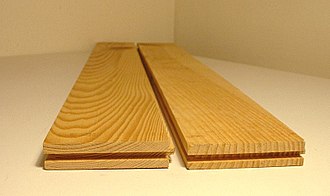Tongue and groove
Tongue and groove is a method of fitting similar objects together, edge to edge, used mainly with wood, in flooring, parquetry, paneling, and similar constructions. Tongue and groove joints allow two flat pieces to be joined strongly together to make a single flat surface. Before the advent of modern woodworking machinery, this method was a hallmark for joining the pieces of wooden furniture, flooring, and paneling.
Overview
Each piece has a slot (the groove) cut all along one edge, and a thin, deep ridge (the tongue) on the opposite edge. The tongue projects a little less than the depth of the groove. Two or more pieces thus fit together closely. The joint is not normally glued, as shrinkage would then pull the tongue off. In another assembly method, the pieces are glued together with adhesives. When joining thicker materials, several tongue and groove joints may be used one above the other.
Applications
Tongue and groove is a technique used to secure timber, in both vertical and horizontal alignments. It is most commonly applied in the installation of hardwood flooring, but also in wooden siding, paneling, and other decorative architectural details. The tight fit provided by this method is effective in preventing the movement between panels, offering a smooth, continuous surface that is aesthetically pleasing and structurally sound.
Advantages
The primary advantage of tongue and groove construction is the tight fit and ease of assembly. The interlocking design allows for a more robust connection between pieces, which is particularly beneficial in flooring applications where the wood needs to withstand significant foot traffic. Additionally, the seamless joinery minimizes the risk of warping or gaps forming between the boards, which can occur in less sophisticated joining methods.
Installation
Installation of tongue and groove flooring or paneling involves aligning the tongue of one piece into the groove of an adjoining piece and pressing the two pieces together until the tongue is fully seated in the groove. This can be done by hand for thinner materials, but for thicker, more robust materials, a rubber mallet or a specialized flooring nailer may be used to ensure a tight fit. Proper installation is crucial to ensure the longevity and durability of the construction.
Maintenance
Maintenance of tongue and groove woodwork involves regular cleaning to remove dirt and grit, which can wear down the finish over time. Additionally, the wood may need to be resealed periodically to maintain its moisture resistance and prevent warping or cracking. Proper care and maintenance can significantly extend the life of tongue and groove constructions, making them a durable option for flooring and paneling.
History
The tongue and groove method has been used for centuries in woodworking and construction, dating back to ancient civilizations. It was a practical solution for creating large, stable surfaces before the invention of modern adhesives and fasteners. The method has evolved with advancements in tooling and machinery, allowing for more precise and efficient production of tongue and groove joints.
This construction related article is a stub. You can help WikiMD by expanding it.
Transform your life with W8MD's budget GLP-1 injections from $125.
W8MD offers a medical weight loss program to lose weight in Philadelphia. Our physician-supervised medical weight loss provides:
- Most insurances accepted or discounted self-pay rates. We will obtain insurance prior authorizations if needed.
- Generic GLP1 weight loss injections from $125 for the starting dose.
- Also offer prescription weight loss medications including Phentermine, Qsymia, Diethylpropion, Contrave etc.
NYC weight loss doctor appointments
Start your NYC weight loss journey today at our NYC medical weight loss and Philadelphia medical weight loss clinics.
- Call 718-946-5500 to lose weight in NYC or for medical weight loss in Philadelphia 215-676-2334.
- Tags:NYC medical weight loss, Philadelphia lose weight Zepbound NYC, Budget GLP1 weight loss injections, Wegovy Philadelphia, Wegovy NYC, Philadelphia medical weight loss, Brookly weight loss and Wegovy NYC
|
WikiMD's Wellness Encyclopedia |
| Let Food Be Thy Medicine Medicine Thy Food - Hippocrates |
Medical Disclaimer: WikiMD is not a substitute for professional medical advice. The information on WikiMD is provided as an information resource only, may be incorrect, outdated or misleading, and is not to be used or relied on for any diagnostic or treatment purposes. Please consult your health care provider before making any healthcare decisions or for guidance about a specific medical condition. WikiMD expressly disclaims responsibility, and shall have no liability, for any damages, loss, injury, or liability whatsoever suffered as a result of your reliance on the information contained in this site. By visiting this site you agree to the foregoing terms and conditions, which may from time to time be changed or supplemented by WikiMD. If you do not agree to the foregoing terms and conditions, you should not enter or use this site. See full disclaimer.
Credits:Most images are courtesy of Wikimedia commons, and templates, categories Wikipedia, licensed under CC BY SA or similar.
Contributors: Prab R. Tumpati, MD

